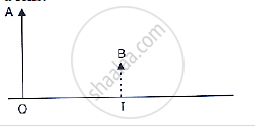Advertisements
Advertisements
Question
A small bulb is placed at the focal point of a converging lens. When the bulb is switched on, the lens produces:
(a) a convergent beam of light
(b) a divergent beam of light
(c) a parallel beam of light
(d) a patch of coloured light
Solution
A parallel beam of light
The reason being, a beam of light coming from the focus of a converging lens becomes parallel, after refraction from the lens.
APPEARS IN
RELATED QUESTIONS
Which type of lens is :
a converging lens, and which is
State one practical use each of convex mirror, concave mirror, convex lens and concave lens.
Which of the following can form a virtual image which is always smaller than the object?
(a) a plane mirror
(b) a convex lens
(c) a concave lens
(d) a concave mirror
An object is placed at a distance of 4 cm from a concave lens of focal length 12 cm. Fine the position and nature of the image.
The power of a converging lens is 4.5 D and that of a diverging lens is 3 D. The power of this combination of lenses placed close together is :
(a) +1.5D
(b) +7.5D
(c) −7.5D
(d) −1.5D
What type of lens is used to correct
myopia?
The following diagram in given below shows an object OA and its virtual image IB formed by a lens.

A lens forms an upright and diminished image of an object irrespective of its position. What kind of lens is this?
A concave lens, if kept at a proper distance from an object, can form its real image.
An object of height 4 cm is kept at a distance of 30 cm from a concave lens. Use lens formula to determine the image distance, nature and size of the image formed if focal length of the lens is 15 cm.
